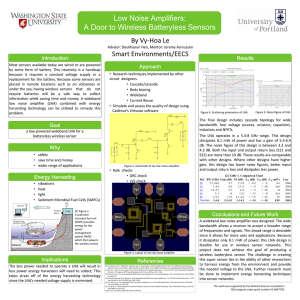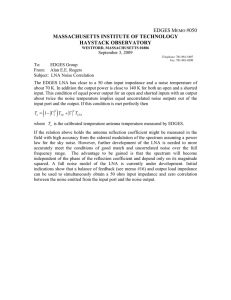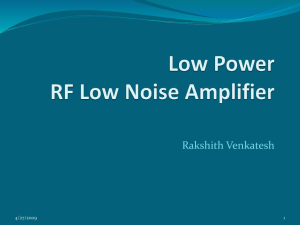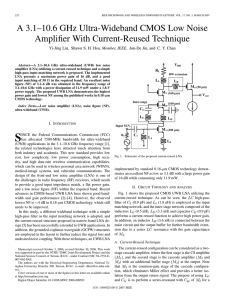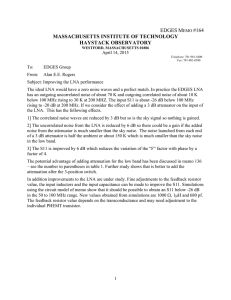Low Noise Amplifier for 2.45 GHz Frequency
advertisement
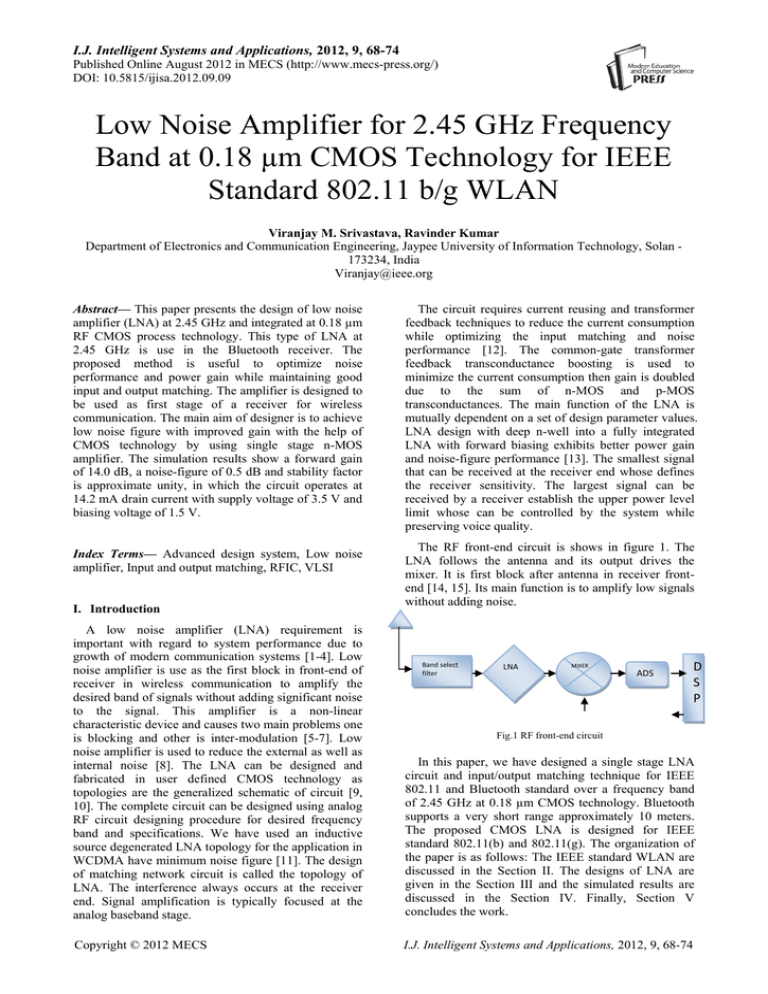
I.J. Intelligent Systems and Applications, 2012, 9, 68-74 Published Online August 2012 in MECS (http://www.mecs-press.org/) DOI: 10.5815/ijisa.2012.09.09 Low Noise Amplifier for 2.45 GHz Frequency Band at 0.18 µm CMOS Technology for IEEE Standard 802.11 b/g WLAN Viranjay M. Srivastava, Ravinder Kumar Department of Electronics and Communication Engineering, Jaypee University of Information Technology, Solan 173234, India Viranjay@ieee.org Abstract— This paper presents the design of low noise amplifier (LNA) at 2.45 GHz and integrated at 0.18 µm RF CMOS process technology. This type of LNA at 2.45 GHz is use in the Bluetooth receiver. The proposed method is useful to optimize noise performance and power gain while maintaining good input and output matching. The amplifier is designed to be used as first stage of a receiver for wireless communication. The main aim of designer is to achieve low noise figure with improved gain with the help of CMOS technology by using single stage n-MOS amplifier. The simulation results show a forward gain of 14.0 dB, a noise-figure of 0.5 dB and stability factor is approximate unity, in which the circuit operates at 14.2 mA drain current with supply voltage of 3.5 V and biasing voltage of 1.5 V. Index Terms— Advanced design system, Low noise amplifier, Input and output matching, RFIC, VLSI I. Introduction The circuit requires current reusing and transformer feedback techniques to reduce the current consumption while optimizing the input matching and noise performance [12]. The common-gate transformer feedback transconductance boosting is used to minimize the current consumption then gain is doubled due to the sum of n-MOS and p-MOS transconductances. The main function of the LNA is mutually dependent on a set of design parameter values. LNA design with deep n-well into a fully integrated LNA with forward biasing exhibits better power gain and noise-figure performance [13]. The smallest signal that can be received at the receiver end whose defines the receiver sensitivity. The largest signal can be received by a receiver establish the upper power level limit whose can be controlled by the system while preserving voice quality. The RF front-end circuit is shows in figure 1. The LNA follows the antenna and its output drives the mixer. It is first block after antenna in receiver frontend [14, 15]. Its main function is to amplify low signals without adding noise. A low noise amplifier (LNA) requirement is important with regard to system performance due to growth of modern communication systems [1-4]. Low noise amplifier is use as the first block in front-end of receiver in wireless communication to amplify the desired band of signals without adding significant noise to the signal. This amplifier is a non-linear characteristic device and causes two main problems one is blocking and other is inter-modulation [5-7]. Low noise amplifier is used to reduce the external as well as internal noise [8]. The LNA can be designed and fabricated in user defined CMOS technology as topologies are the generalized schematic of circuit [9, 10]. The complete circuit can be designed using analog RF circuit designing procedure for desired frequency band and specifications. We have used an inductive source degenerated LNA topology for the application in WCDMA have minimum noise figure [11]. The design of matching network circuit is called the topology of LNA. The interference always occurs at the receiver end. Signal amplification is typically focused at the analog baseband stage. In this paper, we have designed a single stage LNA circuit and input/output matching technique for IEEE 802.11 and Bluetooth standard over a frequency band of 2.45 GHz at 0.18 µm CMOS technology. Bluetooth supports a very short range approximately 10 meters. The proposed CMOS LNA is designed for IEEE standard 802.11(b) and 802.11(g). The organization of the paper is as follows: The IEEE standard WLAN are discussed in the Section II. The designs of LNA are given in the Section III and the simulated results are discussed in the Section IV. Finally, Section V concludes the work. Copyright © 2012 MECS I.J. Intelligent Systems and Applications, 2012, 9, 68-74 Band select filter LNA MIXER ADS D S P Fig.1 RF front-end circuit Low Noise Amplifier for 2.45 GHz Frequency Band at 0.18 µm CMOS Technology for IEEE Standard 802.11 b/g WLAN II. IEEE Standard (802.11b/g) WLAN The Institute of Electrical and Electronics Engineers (IEEE) created the WLAN 802.11(b) standard in Sept. 1999. Standard 802.11(b) supports the bandwidth up to 11 Mbps. These have lowest cost, signal range is 35 meter indoor and 140 meter outdoor and not easily obstructed. In June 2003, WLAN supports the standard 802.11(g). These standard attempts to combine the best of both 802.11(a) and 802.11(g). This standard 802.11(g) supports the bandwidth up to 54 Mbps [16]. These have fast maximum speed and signal range is also better. Table I summarizes the important specification of WLAN standards 802.11(b) and 802.11(g). Table I Summarized WLAN 802.11 (b/g) Standards IEEE Standard 802.11(b) IEEE Standard 802.11(g) Release Sept. 1999 June 2003 Frequency 2.4 GHz 2.4GHz Max. data rate 11 Mbps / 5.5 Mbps 54 Mbps / 24 Mbps / 12 Mbps Modulation DSSS DSSS, OFDM Indoor range 35 meter 38 meter Output range 140 meter 140 meter 69 In the fully integrated two stages LNA, use the resistive shunt-feedback, simplified band-pass filter circuit to achieve wide input impedance matching [18, 19]. The cascoded CMOS topology is widely used in LNA designing to achieve the maximum gain. In the cascoded CMOS LNA, noise-figure (NF) and linearity of a low noise amplifier is directly affected by the gate width and gate-source voltage of common-source transistor. The circuit structure is shown in figure 2. Input Matching stage Single-stage amplifier Output Matching stage Fig.2 Low noise amplifier structure This circuit structure of the proposed LNA consists of input matching stage, single stage amplifier and output matching stage. In this paper, we use the inductively degenerated common source topology as shown in figure 3. III. LNA Circuit Design The LNA have mainly three sections to be designed in complete circuit. 1. 2. 3. Input matching network Main transistor section Output matching network The input matching network is used to make the input return loss (S11) minimized without introducing additional noise. The input matching circuit that terminates the transistor to gamma optimum (Γout) which represents the input impedance of the transistor for the best noise matches. Attenuation is lowest at 77 Ω and power handling capability is highest at 30 Ω. So, the compromise between these two parameters gives the 50 Ω resistive input impedance to design a LNA [17]. Main transistor section ensures a high gain, high linearity and low noise factor at the time of input and output matching. The last step in LNA design involves output matching. The input and output impedance matching is required to maximize the power transfer and minimize the reflections. Smith chart is used for impedance matching. According to maximum power transfer theorem, maximum power delivered to the load when the impedance of load is equal to the complex conjugate of the impedance of source (ZS = ZL*). Copyright © 2012 MECS Fig.3 Single stage inductively degenerated common source configuration This topology has been best choice for many frequency bands due to its noise and gain performance. By the use of changing the source degeneration inductor (LS), we can be improved input matching (S11). The input impedance of single-stage inductive degeneration CMOS LNA is expressed by ( Lin=Lg): Z in j ( Lg Ls ) 1 g L m s jC gs C gs (1) For the input impedance matching, the gate-source capacitance (Cgs) of transistor is used. By the use of parallel LC network, it will neither increase power consumption nor degrade quality factor (QL) [19, 20]: QL 1 oC gs zo (2) where ω0 is the resonant frequency and is defined as in the following equation: o 1 ( Ls Lin )C gs (3) I.J. Intelligent Systems and Applications, 2012, 9, 68-74 70 Low Noise Amplifier for 2.45 GHz Frequency Band at 0.18 µm CMOS Technology for IEEE Standard 802.11 b/g WLAN T gm C gs (4) After that condition, we can be drive output impedance of inductive degeneration CMOS LNA: Z o T Ls (5) At resonance, the voltage across the capacitor and the short circuit output current is defined in equation: Vgs QLVs and iout g mVgs (6) C. Impedance Matching Impedance matching at input and output port done by using smith chart technique, by properly adjusting the value of inductance and capacitance at input and output side, we have managed to match impedance with the terminating resistance of 50 Ω. Γs and ΓL is the source and load reflection coefficient respectively. Input and output reflection coefficient is Γin and Γout respectively shown in following equations: in s11 s12 s21 L 1 s22 L (9) s12 s21 s 1 s11 s (10) where gm is the transconductance of the device. out s22 A. Transconductance The transconductance of the MOS transistor depends on the bias current and device geometry: g m 2k w ID L (7) where k n Cox . The relationship of the input to the output of an amplifier usually expressed as a function of the input frequency is called the transfer function of the amplifier. The common-gate LNA achieves high gain and low noise-figure. It realizes the input matching through a parallel LC network for fully integrated CMOS LNA with on-chip spiral inductors [3, 21, 22]. Inductive degeneration (LS) also improves the linearity by use of a negative series feedback. When we use current reuse topology in LNA then we can reduce the power consumption while preserve highgain. But this topology requires a DC bias as well as biasing resistor then they will create extra noise and signal leakage [8]. The current reuse topology can be used with any circuit like common-source and common- gate. B. S-parameters It is refers to RF output voltage verses input voltage in the RFIC and describes the relationship between the two or more port network. In the term of RFIC, S11and S22 is called reflections coefficient. S21 and S12 are called transmission coefficient. S11 and S22 are used to calculate the input and output reflection in the circuits [23]. S21 and S12 are used to calculate the forward and reverse voltage gain in dB as shown in the figure 4. Fig.4 S-parameters of two port network Copyright © 2012 MECS D. Stability Factor (K) Amplifier is not reliable when it is instable condition. The stability of a circuit is characterized by stern stability factor. The circuit is stable only when K>1 and Δ<1. When the input and output reflection coefficients are less than one then we determined the absolute stability factor: K 1 2 S112 S222 2S11 S22 (11) S11S22 S12 S21 (12) When K<1, then Smith chart is stable but when the K<0, then the Smith chart is unstable [4]. E. Transducer Power Gain It is the ratio of output signal to the input signal and also signals amplification capability of LNA. The CMOS LNA drives the transducer power gain whose power delivered to the load divided by power available from source: GT 1 s 2 1 s11 s s21 2 2 1 L 2 1 s22 L 2 (13) F. Noise-Figure It is the ratio of output SNR to the input SNR in dB: SNRi (14) SNR0 In the cascaded form the noise-factor (F) is given as: NF (dB ) 10.log Ftotal FLNA Fafter .LNA 1 GLNA (15) G. Linearity Linearity of LNA is most important in a wireless receiver to reduce the inter-modulation distortion. The I.J. Intelligent Systems and Applications, 2012, 9, 68-74 Low Noise Amplifier for 2.45 GHz Frequency Band at 0.18 µm CMOS Technology for IEEE Standard 802.11 b/g WLAN linearity is expressed by the 1 dB compression point and inter-modulation product (IP3). When the input signal is increased, a point is reached where the power of the signal is not amplified by the same amount as the smaller signal at the output. At this point where the input signal is amplified by an amount 1 dB less than the small signal gain, these are called 1 dB compression point. IIP3 (input inter-modulation product) is proportional to the ratio of the first and third derivatives of the transfer characteristic. IIP3 is expressed as: IIP3 4 g m1 3 g m3 because this type of frequency used in many applications. (16) H. Spurious-free dynamic range (SFDR) These are use as a specific measure of dynamic range between a lower bound and upper bound of the signal. The Noi as the input referred noise power in dB. The input-referred IM3 power N0. SFDR is expressed as: 2 SFDR [OIP3 - N o ] 3 2 [ IIP3 - N oi ] 3 71 Fig.5 Power gain (S21) of the LNA and achieves a forward gain (S21) of 14.0 dB at 2.45 GHz. (17) SFDR is bounded on one end by IIP3 and on the other by the noise floor. IV. Simulation Results Fig.6 Noise figure of the LNA and achieves a NF of 0.5dB at 2.45 GHz. This simulation section presents the measured results of the single-stage inductive degenerated common source CMOS LNA whose operating at the 2.45 GHz frequency band. This is implemented based on 0.18 µm CMOS technology. The measured S-parameters are shown in figure 5 to figure 9. The CMOS LNA was designed at 2.45 GHz. The forward gain (S21) is 14.0 dB at 2.45 GHz frequency band shown in the figure 5. The designed LNA also shows a 0.5 dB noise-figure in figure 6. The input return loss (S11) and output return loss (S22) is -10 dB and -13 dB respectively shown in the figures 7 and figure 8. And the stability factor very closed to 1 dB is shown in the figure 9. The results shows that the S11<1 and S22<1 whose fulfils the stability condition. Figure the best impedance matching for high forward gain and low noise at 2.45 GHz frequency range. Fig.7 Input reflection coefficient (S11) of the LNA. S11 is -10 dB at 2.45 GHz. The lowest Fmin is 0.3 dB obtained at 2.7 GHz as shown in the figure 6. But we were working at 2.45 GHz so we use the value of noise-figure at 2.45 GHz. A forward gain simulation was performed on the LNA, and results are shown in the figure 5. When we measured result better at frequency 2.6 GHz that is forward gain of approximately 15 dB and noise-figure of 0.3 dB. But we will see all result at 2.45 GHz, Copyright © 2012 MECS Fig.8 Output reflection coefficient (S22) of the LNA. S22 is -13 dB at 2.45 GHz. I.J. Intelligent Systems and Applications, 2012, 9, 68-74 72 Low Noise Amplifier for 2.45 GHz Frequency Band at 0.18 µm CMOS Technology for IEEE Standard 802.11 b/g WLAN References [1] Yu Lin Wei and Jun De Jin, “A low power low noise amplifier for K-band applications,” IEEE Microwave and Wireless Components Letters, vol. 19, no. 2, pp. 116-118, Feb. 2009. [2] A. Meaamar, Boon Chirn Chye, Man Anh, and Yeo Kiat Seng, “A 3 to 8 GHz low noise CMOS amplifier,” IEEE Microwave and Wireless Components Letters, vol. 19, no. 4, pp. 245-247, April 2009. Fig.9 Stability factor (K) of an LNA at 2.45 GHz. V. Conclusions In this paper, design and implementation of a Low noise amplifier based on inductively degenerated common source topology at 2.45 GHz were presented. The LNA has been designed in a 0.18µm CMOS technology. An ADS was used for circuit design and simulation and 0.18 µm CMOS technology are used. At 3.5 V supply, LNA achieves a forward gain, noise figure and reflection coefficient operating at 14.2 mA drain current. Summary of the proposed LNA performance is shown in Table II. A better noise and gain performance were achieved. A power gain of 14.0 dB and noise figure of 0.5 dB were obtained for the proposed LNA. Input reflection (S11) and output reflection coefficients (S22) of -10 dB and -13 dB respectively were achieved. Low noise amplifier is used in IEEE 802.11b/g standards for wireless local area network. They are now also used for communication like Wi-Fi and Bluetooth applications [24-26]. Table II. Summary of the proposed LNA performance Parameters Frequency Measured Results 2.45 GHz Power gain (S21) 14.0 dB Noise-figure (NF) 0.5 dB Drain current Supply voltage 14.2 mA 3.5 V Acknowledgement The authors would like to thank Prof. G. Singh, Department of Electronics and Communication Engineering, Jaypee University of Information Technology, Solan, India, who permit to take the reference of their work related to Silicon RF CMOS Technology. The authors also thank Prof. K. S. Yadav, Sr. Scientist, CEERI, Pilani, India for many insightful discussions. Copyright © 2012 MECS [3] Roee Ben Yishay, Sara Stolyarova, Shye Shapira, Moshe Musiya, David Kryger, Yossi Shiloh, and Yael Nemirovsky, “A CMOS low noise amplifier with integrated front-side micro-machined inductor,” Microelectronics Journal, vol. 42, no. 5, pp. 754-757, May 2011. [4] Ravinder Kumar, Munish Kumar, and Viranjay M. Srivastava, “Design and noise optimization for a RF low noise amplifier,” Int. J. of VLSI Design and Communication Systems, vol. 3, no. 2, pp. 165-173, April 2012. [5] Nazif Emran Farid, Arjuna Marzuki, and Ahmad Ismat,“A variable gain 2.5 GHz CMOS low noise amplifier for mobile wireless communications,” Proc. of 9th IEEE Int. Conf. of communications, Malaysia, 15-17 Dec. 2009, pp. 885-889. [6] Wei Guo and Daquan Huang, “The noise and linearity optimization for 1.9 GHz CMOS low Noise Amplifier,” Proc. of IEEE Asia Pacific Conf. on ASIC, Taiwan, 6 - 8 Aug. 2002, pp. 253257. [7] Jose Carlos Pedro and Nuno Borges Carvalho, Intermodulation distortion in microwave and wireless circuits, Artech Publication House, 1st Ed., 2003. [8] Bo Huang, Chi Hsueh Wang, Chung Chun Chen, Ming Fong Lei, Pin Cheng Huang, Kun You Lin, and Huei Wang , “Design and analysis for a 60 GHz low noise amplifier with RF ESD protection,” IEEE Trans. on Microwave Theory and Techniques, vol. 57, no. 2, pp. 298-305, Feb. 2009. [9] Viranjay M. Srivastava, K. S. Yadav, and G. Singh, “Analysis of drain current and switching speed for SPDT switch and DPDT switch with proposed DP4T RF CMOS switch,” J. of Circuits, Systems and Computers, vol. 21, no. 4, pp. 1-18, June 2012. [10] Viranjay M. Srivastava, K. S. Yadav, and G. Singh, “Design and performance analysis of double-gate MOSFET over single-gate MOSFET for RF switch,” Microelectronics Journal, vol. 42, no. 3, pp. 527-534, March 2011. [11] Norlaili, Tun Zainal and Azni Zulkifli, “A 1.4 dB noise figure CMOS LNA for WCDMA I.J. Intelligent Systems and Applications, 2012, 9, 68-74 Low Noise Amplifier for 2.45 GHz Frequency Band at 0.18 µm CMOS Technology for IEEE Standard 802.11 b/g WLAN 73 application,” Proc. of IEEE RF and Microwave Conf., Malaysia, 12-14 Sept. 2006, pp. 143-148. Electronics Letters, vol. 41, no. 2, pp. 66-68, Jan. 2005. [12] Wenjian Chen, Tino Copani, Hugh J. Barnaby, Sayfe Kiaei, “A 0.13 µm CMOS ultra-low power front-end receiver for wireless sensor networks,” Proc. of IEEE Radio Frequency Integrated Circuits Symposium, Honolulu, 3-5 June 2007, pp. 105-108. [23] Viranjay M. Srivastava, K. S. Yadav, and G. Singh, “Capacitive model and S-parameters of double-pole four-throw double-gate RF CMOS switch,” Int. J. of Wireless Engineering and Technology, vol. 2, no. 1, pp. 15-22, Jan. 2011. [13] S. F. Wan Muhamad Hatta, N. Soin, “Performance of the forward-biased RF LNA with deep n-well n-MOS transistor,” Proc. of IEEE Int. Conf. on Semiconductor Electronics, Malaysia, 25-17 Nov. 2008, pp. 466-469. [14] Viranjay M. Srivastava, K. S. Yadav, and G. Singh, “Design and performance analysis of cylindrical surrounding double-gate MOSFET for RF switch,” Microelectronics Journal, vol. 42, no. 10, pp. 1124-1135, Oct. 2011. [15] Viranjay M. Srivastava, K. S. Yadav, and G. Singh, “Analysis of double gate CMOS for double-pole four-throw RF switch design at 45nm technology,” J. of Computational Electronics, vol. 10, no. 1-2, pp. 229-240, June 2011. [16] Massimo Brandolini, Paolo Rossi, Danilo Manstretta and Francesco Svelto, “Toward multistandard mobile terminals-fully integrated receivers requirements and architectures,” IEEE Trans. on Microwave Theory and Techniques, 2005, pp. 1026-1038. [17] Thomas H. Lee, The design of CMOS radiofrequency integrated circuits, Cambridge Univ. Press, 2nd Ed., 2004. [18] Man Long Her, Hao Chih Hsu, Hsin Hung Lin, Tseng Hsow Yuan and Shun Ping Chan, “Design and implementation of LNA for 2 to 6 GHz WIMax system,” Proc. of 15th IEEE Asia Pacific Conf. on Communications, China, 8-10 Oct. 2009, pp. 426-429. [19] Hosein Alavi Rad, Goodarz Cheraghi and Soheil Ziabakhsh, “A low power CMOS LNA for 2.45 GHz band IEEE 802.15.4 standard in 0.18µm technology,” Proc. of 5th IEEE European Conf. on Circuits and Systems for Communications, Serbia, 23-25 Nov. 2010, pp. 78-81. [20] Hsieh Hung Hsieh, “A 40 GHz low noise amplifier with a positive-feedback network in 0.18 μm CMOS,” IEEE Trans. on Microwave Theory and Techniques, vol. 57, no. 8, pp. 1895-1902, Aug. 2009. [21] Kiat Seng Yeo, Manh Anh Do, and Chirn Chye Boon, Design of CMOS RF integrated circuits and systems, World Scientific Publications, 1st Ed., 2010. [22] Y. S. Wang and L. H. Lu, “5.7 GHz low power variable gain LNA in 0.18 µm CMOS,” Copyright © 2012 MECS [24] Mu Chun Wang, Hsin Chia Yang, and Yi Jhen Li, “Minimization of cascade low noise amplifier with 0.18 μm CMOS process for 2.4 GHz RFID applications,” Electronics and Signal Processing, Lecture Notes in Electrical Engineering, vol. 97, pp. 571-578, 2011. [25] Lawrence Harte, Introduction to bluetooth, Althos Publications, 2nd Ed., 2009. [26] Chang Hsi Wu and Yu Po Lin, “A low power CMOS low noise amplifier for UWB applications,” Proc. of IEEE Int. Conf. on Ultra Wideband, China, 20-23 Sept. 2010, pp. 13281331. Viranjay M. Srivastava received the Bachelor degree (2002) in Electronics and Instrumentation Engineering from the Rohilkhand University, Bareilly, India and the Master degree (2008) in VLSI design from Center for Development of Advanced Computing (C-DAC), Noida, India and Doctorate (2011) in the field of RF Microelectronics and VLSI Design from Jaypee University of Information Technology, Solan, Himachal Pradesh, India. He was with the Semiconductor Process and Wafer Fabrication Center of BEL Laboratories, Bangalore, India, where he worked on characterization of MOS devices, fabrication of devices and development of circuit design. Currently he is a faculty in Jaypee University of Information Technology, Solan, Himachal Pradesh, India. His research and teaching interests includes VLSI design and CAD with particular emphasis in low-power design, Chip designing, VLSI testing and verification. He has more than 8 years of teaching and research experience in the area of VLSI design, RFIC design, and Analog IC design. He has supervised a number of B. Tech. and M. Tech. theses. He is a member of IEEE, ACEEE and IACSIT. He has worked as a reviewer for several conferences and Journals both national and international. He is author of more than 50 scientific contributions including articles in international refereed Journals and Conferences and also author of two Books, 1) VLSI Technology, and 2) Characterization of C-V curves and Analysis, Using VEE Pro Software: After Fabrication of MOS Device. I.J. Intelligent Systems and Applications, 2012, 9, 68-74 74 Low Noise Amplifier for 2.45 GHz Frequency Band at 0.18 µm CMOS Technology for IEEE Standard 802.11 b/g WLAN Ravinder Kumar received the Bachelor degree (2009) in Electronics and Communication Engineering from Kurukshetra University, Kurukshetra, India and Master degree (2012) in Electronics and Communication Engineering from Jaypee University of Information Technology, Solan, India. His research interest includes RFIC design, VLSI design, Networking and Wireless Communication. Copyright © 2012 MECS I.J. Intelligent Systems and Applications, 2012, 9, 68-74
